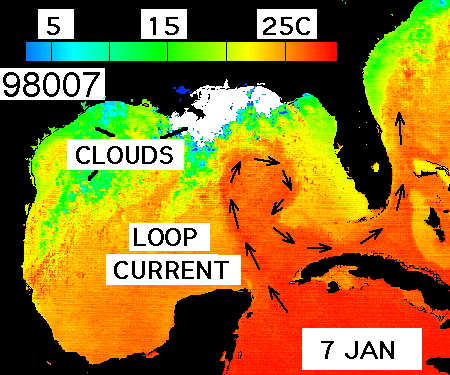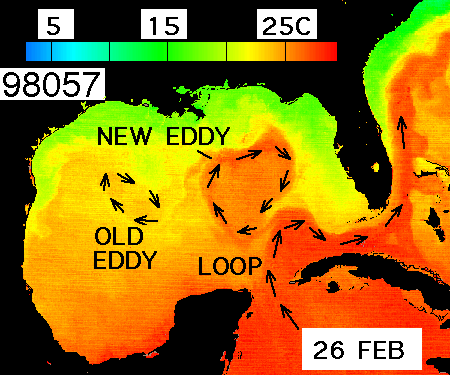

Fig. 1. Satellite SST showing Loop Current at left and "pinching off" of anticyclonic eddy on right.
OC4331-Mesoscale
Oceanography
Final Project Summary
Topic Area:
LCDR Mark Pickett (NOAA)
LT Barbra Dubsky (RAN)
The best-known and most highly studied mesoscale features in the Gulf of Mexico are The Loop Current and the anticyclonic rings that it sheds. The rings that are generated every 9-13 months by it's "pinching off" and the current are presented. The general circulation and variability of these features is shown using data from the Bryan-Cox-Semtner primitive equation model and observational data. Ring interactions with topography and other rings are also presented using hydrographic and surface drifter data.
The importance of these mesoscale features on the circulation, transport, and biology of the Gulf of Mexico is highlighted. The Gulf of Mexico has one of the most productive fisheries in the United States and serves as the spawning ground for some of the largest fish in the world. The physical and biological impacts and contributions of the Loop Current and it's eddies is shown using data from Biggs and Muller, 1994; Bakun, 1996; and Zimmerman and Biggs, 1999.


Fig. 1. Satellite SST showing Loop Current at left and "pinching off" of anticyclonic eddy on right.
Bakun, A., 1996. "Patterns in the Ocean: Ocean Processes and Marine Population Dynamics." California Sea Grant College System, National Oceanic and Atmosheric Administration/CIB, La Paz, BCS Mexico.
Biggs, D.C. and F.E. Muller-Karger, 1994. "Ship and satellite observations of chlorophyll stocks in interacting cyclone-anticyclone eddy pairs in the western Gulf of Mexico." J. Geophys. Res., Vol. 99, 7,371-7,384.
Elliott, B.A., 1982. "Anticyclonic Rings in the Gulf of Mexico." J. Phys. Oceanogr., Vol. 12, 1292-1309.
Lewis, J.K. and A.D. Kirwan, 1985, "Some Observations of Ring Topography and Ring-Ring Interactions in the Gulf of Mexico" J. Geophys. Res., Vol. 90, 9,017-9,028.
Sturges, W., J.C. Evans, S. Welsh, and W. Holland, 1993. "Separation of Warm-Core Rings in the Gulf of Mexico." J. Phys. Oceanogr., Vol. 23, 250-268.
Zimmerman, R.A. and D.C. Biggs, 1999. "Patterns of distribution of sound-scattering zooplankton in warm- and cold-core eddies in the Gulf of Mexico, from a narrowband acoustic Doppler current profiler survey." J. Geophys. Res., Vol. 104, 5,251-5,262.
|
This is a government-maintained internet site. Please read the U.S. Navy web page disclaimer and the dislaimer regarding external links. |
|